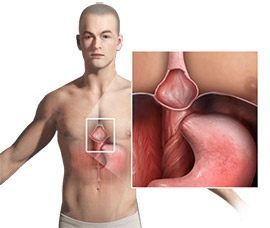Hiatal Hernia Condition

Description
The stomach lies below the diaphragm. Hiatal hernia is a condition in which part of the stomach slides through, an opening in the diaphragm, and protrudes into the chest. Hiatal hernia is a common condition and commonly affects people over 50 years of age.
Hiatal hernia is of two types:
- Sliding hiatal hernia: Most common type of hiatal hernia where the stomach slides in and out of the hiatus.
- Rolling Hiatal hernia (or paraoesophageal hernia): The stomach moves up into the chest cavity on one side of the oesophagus and stays there.
Sometimes the hernia may get strangulated, blocking the blood flow to the stomach. This is a medical emergency.
Causes
It is not exactly clear what causes a hiatal hernia. Some of the possible causes may include weakening of the supporting tissues due to an injury, or increased pressure in the abdomen from coughing, vomiting, lifting heavy objects and straining during a bowel movement. The condition may also occur due to a congenital defect where the hiatus is unusually large.
Impact
A small hiatal hernia may not cause any problem, but a more severe one causes gastro-oesophageal reflux disease (GORD), characterised by heartburn and nausea after meals, which can significantly interrupt your quality of life.
Anatomy
The diaphragm is the muscular sheet that separates the lungs and chest from the abdomen and helps in breathing. The oesophagus or food pipe passes through the diaphragm at the hiatus and opens into the stomach, which is present below the diaphragm.
Symptoms
Hiatal hernia may not have any symptoms. Some of the commonly observed symptoms of hiatal hernia include chest pain, heart burn, belching and difficulty swallowing.
Diagnosis
Your doctor may order the following tests to diagnose hiatal hernia:
- Barium swallow test: involves swallowing a barium preparation, which can be detected through X-rays.
- CT scan may be useful.
- Gastroscopy: allows the doctor to examine the inside of your oesophagus and stomach with an instrument called an endoscope, a thin flexible lighted tube
Treatments

Treatment may not be necessary if the patient is not experiencing symptoms. Treatment is usually started when symptoms occur such as in cases of severe heartburn, when the oesophagus gets inflamed due to acid reflux, the hiatus narrows or lungs are inflamed. Your doctor prescribes medications and life style changes to treat heartburn and acid reflux. Surgery is recommended if medications do not work. . A hernia repair surgery is usually performed as a keyhole (laparoscopic) surgery, where the bulge is pushed back into place, the hiatus is tightened and the stomach is secured into place with sutures.
In open hernia repair, a large incision is made on the chest or abdomen but this is rarely required. Laparoscopic hernia surgery is a surgical procedure in which a laparoscope (fibre optic tube with a camera attached) is inserted into the abdomen through a small incision to perform the surgery.
Prognosis
Medical interventions can successfully relieve symptoms of hiatal hernia in the majority of patients. However, symptoms may continue in some patients necessitating surgery to relieve symptoms.

Untreated
If left untreated, a hiatal hernia can cause complications such as slow bleeding leading to iron deficiency anaemia, lung aspiration and strangulated hernia, where the hernia becomes twisted, cutting off the blood supply to the stomach.






